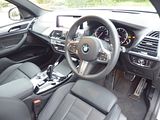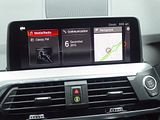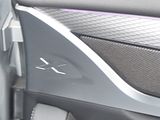The first generation of the BMW X3 arrived in 2004, following the now not uncommon approach of a “teaser” concept car that did the rounds of the Auto Shows a few years earlier. Hard though it may be to remember it now, given the huge sales volumes that Crossovers of all sizes and price points now achieve the world over, at the time, the idea of a car like this was quite radical. BMW had proved to themselves that there was a market for something which combined the practicality benefits of a SUV or Crossover with an element of sportiness with their X5, but that was a large and quite pricey proposition, so it was only natural that they would conclude that the formula should work one size down. Trouble was, the first X3 was, truth be told, not that good a car, at least at launch. BMW worked hard to try to address some of the stated shortcomings, but as they did so, other manufacturers began to see the market potential, and suddenly a car that had few rivals at launch found itself facing ever more competition, with toughest market rivals Audi and Mercedes introducing direct competitors with their Q5 and GLK respectively. Others would follow suit. The second generation X3 was, by all accounts (I never got to sample one) a much better car, and even though it had a lot of rivals to fend off, sales really took off as part of the market shift away from traditional saloon and estate cars to the crossover genre. Building on the success of 1.5 million sales from the first two X3 series, the third generation model, known in BMW speak as the G01, was unveiled in June 2017, and it represented a considered evolution from its predecessor in all regards, with styling that meant that you might need a second glance to tell the latest car apart from the F15 second generation version. Under the skin, it took advantage of the latest BMW technologies in terms of platform, engines and running gear as well as boasting far more safety features and a higher level of standard and optional equipment. A vast range of different models emerged, with individual markets not necessarily getting all of the available variants. So earlier in the year, when I got to sample a US market X3, I found that the car I was driving, an sDrive30i was pretty much at the bottom of the range offer to American buyers, whereas in Europe and the UK most of the large numbers of X3 models have a designation (which long since ceased to tell you the actual size of the engine) which has a 20 in it, or even an 18. Whilst the M cars capture the headlines, and there is now an M version of the X3, volume sales for the X3, just as with its half-brother, the 3 Series, come from much nearer to the bottom of the range. I was a little luke-warm about that US market X3, finding little of significance to criticise, but equally little that truly impressed or made me say this was anything better than a competent but rather uninspiring product. It was with some interest, therefore, that I took the key for a day to a UK market X3, which was supplied as a dealer loan car whilst mine was in for a service. It got a car in the most popular UK market spec, the catchily titled X3 xDrive20d M-Sport.
Despite all the negative publicity surrounding diesel engines in the last few years, and steadily reducing sales of cars powered by it, this fuel remains an important option for buyers of cars of this type, many of whom will be covering high mileages where fuel economy and range are important. In the case of the xDrive20d, the 20 really does mean the engine is a 2 litre. It is a four cylinder engine, designated B57 which features in a number of other BMW models and is the more powerful of two model designations to use the same engine (there is an XDrive18d as well). The B57 engine took over from the earlier N57 in 2015 and represented BMW’s program of continuous development and improvement, offering slightly more power and lower emissions than the outgoing unit. Interestingly, the 20d diesel engine now boasts slightly more power than the 20i petrol engine. Successive versions of the engine and that program of continuous improvement result in a very refined unit indeed. There is keyless starting. Long gone are the days when there is the characteristic diesel rattle on start up, now you get just the slightest of aural clues that you will need to use the black pump when it comes to refuelling time. The engine is smooth and refined, emitting low levels of noise even when worked quite hard. Ultimately, though this X3 is not that fast, which is perhaps not a surprise given the output is 188 bhp and this is quite a large and heavy car. That said, there is more than enough acceleration to allow you to keep up with the traffic flow and the very smooth 8 speed Steptronic automatic gearbox will instantly find the right ratio to ensure you can make the best of the power and torque on offer. There is a traditional BMW gearlever which proves easy enough to use and the car featured paddles if you really want to change gear yourself, though I found the car made a much better job of it than I did. One underway, there was some wind noise but the rain and spray masked any potential tyre noise sources. You get a choice of driving models: Sport, Comfort and EcoPro, which make all the usual sort of changes that you might expect, I opted to leave the car in Comfort mode, and was pleased to find that the ride on the 275/40 R20 wheels was nothing like as punishing as some M-Sport BMWs can prove to be. Not that “sport” really applies here. This is primarily a family-oriented car, at least in xDrive 20d spec, and getting fun out of driving is not really a feature, or perhaps, even the point. Indeed, my notes use the word “unremarkable” in describing the experience. The steering is typical of modern BMWs, in that it is quite a bitter lighter than you expect and there is rather less feel than would seem ideal, though it does get better the more you turn the wheel, but there’s nothing truly poor here, as the chassis is clearly well developed and there is 50/50 weight distribution, so the X3 certainly holds the road well, with ample grip, and it corners tidily enough. It stops well, too. But this is not really a car that gets close to the “Ultimate Driving Machine” tagline that once really did epitomise BMW products. All diesel engine X3 models in the UK have standard all-wheel drive, which in normal motoring splits the power 40/60 to front and rear wheels, but this can vary if the need arises, but this is not really a car that many owners will ever take further off-road than a muddy car park, even though, by all accounts, it could do more than that thanks to its 204mm ride height, reasonable approach and departure angles and a 500mm wading capability. This was not something I tested on a wet and grimy December day, where I was more appreciative of the stability that the system would bring to the car if the worst were to happen. Needless to say, all the latest safety features are part of the standard spec, though you want ones like Lane Keep Assist is perhaps a moot point. Visibility is about as good as you get form any modern car with a high set waistline but there is a rear-view camera and the parking sensors are helpful when manoeuvering. It rained a lot during the day I had this X3 and I did notice that the rear window is particularly prone to picking up rain and dirt.
You do not need a BMW badge on the steering wheel to know that the interior of the X3 is a BMW, as it follows the family style that has been evident on models in the range until the latest 3 Series which has tried (too hard, in my opinion!) to modernise things and indeed at first glance the inside of this car looks little different from its predecessor. The result is a mix of good and bad. But mostly good, I would say. The overall feeling of quality is not as strong as you would experience in a equivalent Audi or Volvo, but it has been carefully optimised to be “just good enough”, which is a phrase that characterises so much about this car. Fit and finish is good, but there is nothing special here despite the use of plenty of soft plastics for the dash moulding and some metallised inlays to provide some colour and texture contrasts. There is a leather wrapped wheel which in true BMW fashion is rather too chunky even for my hands. The digital instruments are grouped together under a single binnacle, with the two large dials for speedometer and rev counter flanked by much smaller ones for fuel level and water temperature. There is the usual BMW problem that the odometer is at the very bottom of the cluster and with my driving position, I simply cannot see it from on the move. One thing I did appreciate was the Head-up Display. There are two conventional column stalks for the indicators and wipers, with lights operated by a rotary dial on the dash to the right of the wheel. These have an Auto function. The centre of the dash is comminated by the infotainment touch screen which is mounted high. It’s not the largest display around, but this sixth generation iDrive system has graphics that are crisp and the system proved very easy to use with the iDrive control wheel and some buttons in the centre console all proving familiar to anyone who has driven any recent BMW. Alternatives are around voice commands and some element of gesture control. There are still an array of buttons for radio pre-set stations and you still get a CD slot with this (optional) Harman Kardon audio unit. Beneath the touch screen are an array of buttons for the dual zone climate control.
There is a feeling of space in the passenger compartment, with headroom especially generous even though you do feel to be sitting quite high in the X3. The seats of the test car were trimmed in leather but, as is often the case with BMW models from near the bottom of their respective ranges, it did not feel to be of particularly high quality. Seat adjustment is all manual, and as is often the case on BMWs, there is an extensible seat bolster for those who – unlike me – have long thigh bones. Combine the range of adjustments with the steering wheel that telescopes in/out and up/down and there should be a driving position to suit everyone. I certainly found no problems in getting what I wanted. Unlike the US test car, I did not drive this one all that far, but from what I could tell, the M-Sport seats seemed comfortable, with support in all the right places.
Like most cars, the third generation X3 grew in external dimensions compared to its predecessor and some of that has gone to the benefit of those who occupy the rear seats. Space in the back is good, with ample leg room even in the front seats are set well back. The central console unit does not come back too far, so a middle seat passenger could fit in here with reasonable comfort. The SUV styling means that there is also particularly generous headroom. There is a drop-down central armrest with a pair of cupholders in the upper surface and there are air vents and climate control settings for the occupants here. What they don’t get are map pockets on the back of the front seats so the only place for odds and ends are the rather small door pockets. The boot is a good size and is a nice regular shape. The load area is flush with the base of tailgate, so sliding large and heavy items in and out should prove easy. There are plenty of hooks to allow you to secure items and stop them sliding around. The rear seat backrests are asymmetrically split and simply fold down to create a much longer and flat load platform for those really bulky loads. Like so man cars now, the tailgate is large and heavy but there is an electric close mechanism on this one, which is welcome. The glovebox has a huge lid, but when you open it up, the space inside is nothing like as large as you might have expected. It would likely still prove adequate for most people’s needs, though. There are also pockets on the doors, and a useful cubby under the central armrest as well as an area in front of the gearlever and a small lidded recess above the driver’s right knee for the odds and ends that accumulate in any car, most especially one with a family orientation.
There’s quite an array of X3 models available in the UK, as you might expect, with a choice of petrol and diesel engines on offer, and from 2018, an explosive and very costly X3M joined the range. That will only ever sell in small numbers, though, so it is the less potent cars that you will see most often. The badging will tell you the relative power, and in Europe anything with a 30 or 40 in it has 6 cylinders, whereas the 18 and 20 models are 4 cylinder units. The least potent petrol models are available in two wheel drive, denoted by sDrive whereas all the diesels are all-wheel drive, called xDrive. There are three “standard” trim versions, which are SE, xLine and M Sport, and these apply to the car regardless of the engine fitted. After that, there are vast numbers of options and configuration choices to make, many of which will hike the price quite considerably. M Sport is a mixture of styling changes, designed to make the car look more sporty and stiffer suspension and a lower ride height to make it more, well, sporty, to drive. These days even the entry level spec is quite generous. SE models get LED headlights, leather seats, heated front seats, 18-inch alloys, three-zone air conditioning and ambient lighting with six colours. The xLine car adds sports front seats, 19-inch wheels and some extra body styling for a classier look. As ever, M Sport will be the pick for most with its racier styling, M badges and lowered suspension. Extra-cost options include BMW’s excellent head-up display (on the test car), variable dampers, various parking aids, a panoramic roof, reconfigurable digital instruments and a loadbay rail system and a whole lot more. Picking BMW’s Professional Multimedia option (£680) and then adding the Technology Package (£1545) bundles together gesture control, a wi-fi hotspot, wireless smartphone charging and BMW’s digital instruments. Music lovers might also want to spend £160 on BMW’s Online Entertainment internet music streaming option and £820 on a Harman Kardon stereo. In short, you can have the system you want – if you pay for it. BMW doesn’t even give you Apple CarPlay as standard. With this X3, though, BMW became the first car maker to integrate a Microsoft Exchange email server connection into its cars and the X3 offers this at extra cost, allowing you to edit and send business emails securely. So you get some unexpected features included as standard but other things you want are certainly going to cost you.
Reflecting on the X3, as I was about to hand it back, I had some mixed feelings. As every day family transport, there is little doubt that this car would fit the bill perfectly. It is roomy, well finished, goes well enough and has the right sort of prestige badge which seems to matter to so many people these days. There is nothing significant to criticise. But, there was absolutely no spark about this X3. It is in many ways a typical entry level BMW, perfectly competent, but lacking in desirability beyond the image denoted by the badge. And that could be OK until I refer back to my researches which elicited the fact that with a couple of thousand pounds of options fitted, the list price of this car was well north of £45,000. That strikes me as an awful lot of money for a family car, a car which whilst competent, seemed utterly “ordinary”. The saving grace is the fact that although the list price is indeed over £45,000, the reality is that BMW are in the volume game these days, and it is well documented that they are super-keen to offer what seem like suicidal discounts without you even asking, and they show signs of equal desperation when it comes to the finance deals. So whilst something with a less premium-sounding badge and a much lower price tag, like a VW Tiguan or a Mazda CX-5 might seem like a more rational purchase, when you get the real cost from the dealer, you may just find that the BMW is nowhere near as over-priced as you first thought. On that basis, it could make rather more sense. Personally, I would rather have an Alfa Romeo Stelvio, but I know that the harsh realities of the finance deals mean that whilst on paper the two would appear to cost the same, the reality is owning the BMW would be so much cheaper that it is understandable why many will pick the BMW.






































